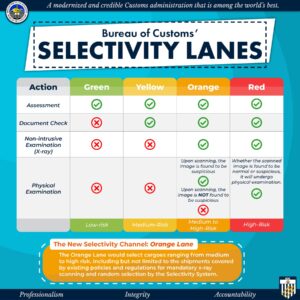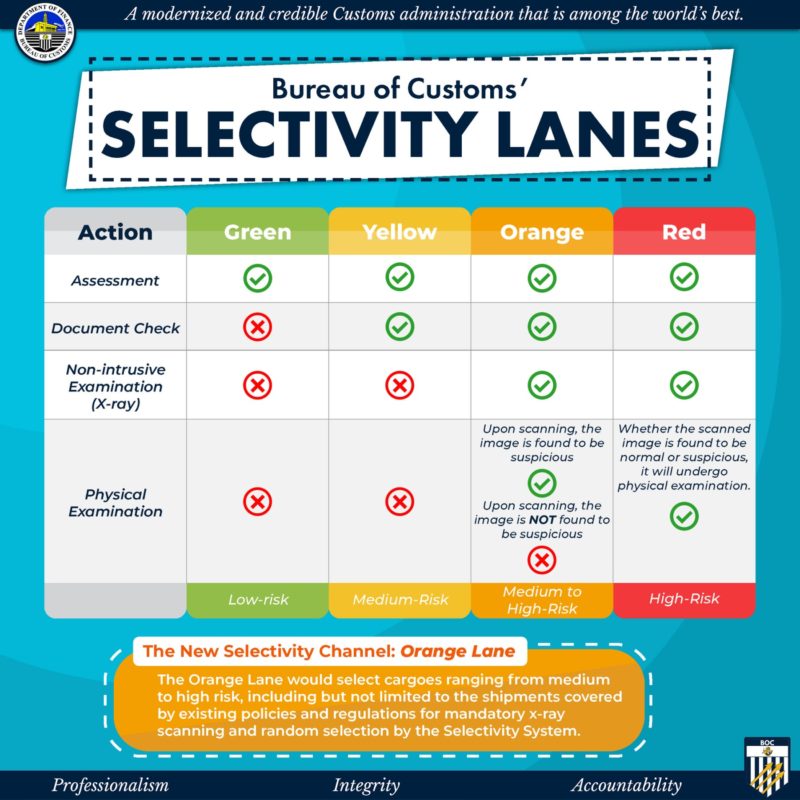
From October 1, the Bureau of Customs (BOC) is implementing the “orange lane,” a new color lane in addition to the red, yellow, and green lanes under its selectivity system.
Customs Commissioner Rey Leonardo Guerrero in a memo dated September 15 directed the establishment of the orange lane under the BOC’s Universal Risk Management System (URMS). The lane is to be implemented via the Electronic-to-Mobile (e2m) System.
READ: BOC activates ‘orange lane’ for medium, high risk cargoes
BOC earlier said the new color lane has been activated “to maximize non-intrusive inspection for an enhance trade facilitation while ensuring strengthened border protection and revenue collection.”
Under the new policy, the orange lane is assigned to medium- to high-risk cargoes. Goods declaration tagged orange will have to pass through x-ray scanning, and be subjected to physical examination if a suspicious image is found.
The orange lane has become the red lane, noted Chamber of Customs Brokers, Inc. president Adones Carmona. Previously, it was red lane shipments that went through x-ray examination and, if something was off, had to go through physical inspection.
In the new system, the “red lane” will cover high-risk cargoes, which are subject to both x-ray scanning and physical examination.
BOC said in a September 30 advisory that goods declaration lodged and selected for the red lane until September 30 will still be covered by the previous treatment for red lane-tagged shipments.
Meanwhile, the “yellow lane” is for cargoes which have low to medium risk and are subject to document check.
The “green lane” is dedicated to cargoes which have no to low risk and do not require documentary review or inspection.
BOC also has “super green lane,” a special facility where accredited members, consisting of multinational companies and members of the top 1000 corporations, are accorded the privilege of advance processing and clearance of shipments.
BOC’s selectivity system refers to the use of risk-based color channeling to manage risks and allow the agency to “allocate its scarce resources to the high-risk areas while increasing the efficiency of the clearance process for low-risk shipments.”
Last June, the agency introduced the Universal Risk Management System (URMS), which is intended to improve its risk management capabilities. BOC plans to migrate information to URMS, which has a more user-friendly interface, allows a larger amount of information to be stored, and promotes a paperless system.
READ: BOC adopts new risk management system
The URMS has been initially implemented at all ports and is expected to provide the Risk Management Office (RMO), which oversees BOC’s selectivity system, with a quicker means of tagging shipments.
RMO said selection under the URMS is analytics-based through a memory-based reasoning feature that “enables risk and compliance prediction” as an artificial intelligence tool so as to promote automation and lessen human intervention in assisting traders.
RMO has been working to secure the pipeline of information and feedback mechanism through “maximization of its data sources using modernized systems and upholding a viable structure of setting and updating Selectivity Screens in the thrust to sustain effective machine learning.”
To further improve the URMS, the Customs Risk Management Steering Committee continues to develop action plans encompassing all the areas in the delivery of an enhanced risk management system of the agency, BOC said.
Relatedly, BOC has also issued Customs Memorandum Order No. 21-2020, which took effect on September 1. The memorandum order covers the operational procedures of BOC’s RMO for data gathering and analysis, risk assessment, profiling and targeting, updating of the selectivity criteria and parameters, and monitoring and evaluation of the results.
READ: BOC issues procedures for improved cargo selectivity system
It also covers the roles of other concerned offices and/or collection districts nationwide in improving the risk management process and selectivity system. – Roumina Pablo





